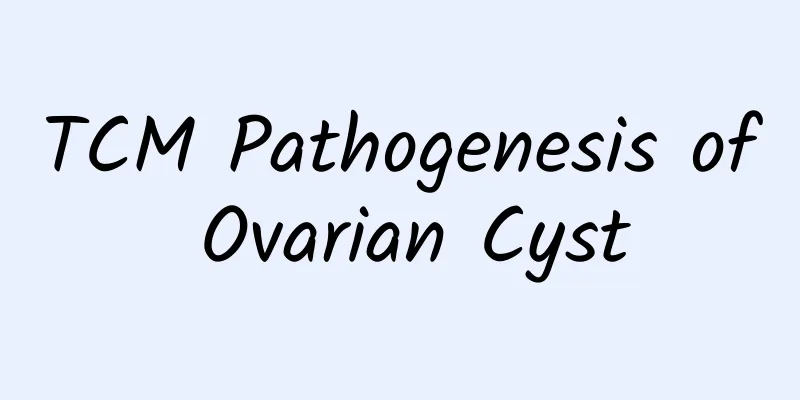TCM Pathogenesis of Ovarian Cyst

|
Ovarian cyst is a common gynecological disease. Traditional Chinese medicine classifies ovarian cyst as a "symptom and mass". Symptoms are hard masses that are fixed and cannot be dislodged by pushing and kneading. The pain is in a fixed place. This is a blood disease. Masses are full and invisible. They gather and disperse from time to time. They are pushed and kneaded and the pain is in no fixed place. This is a qi disease. Traditional Chinese medicine believes that the pathogenesis is mostly due to disharmony of the internal organs, obstruction of qi, and stagnation of blood. Qi gathering is a symptom, and blood stasis is a mass. Qi stagnation, blood stasis, phlegm dampness, and toxic heat are the most common. 1. Qi stagnation Qi stagnation is mostly caused by the patient's emotional discomfort, which leads to liver qi stagnation and obstruction of qi and blood circulation, which stagnate in the Chong, Ren and uterus, and eventually accumulate in the lower abdomen, becoming a qi stagnation syndrome. 2. Blood stasis On the one hand, Qi flows with blood, and stagnation of Qi causes blood stasis, which can lead to cyst formation over time. On the other hand, during menstruation and after childbirth, women's uterine vessels are empty, and the remaining blood has not been completely drained. If they have excessive sexual intercourse, or if external evils invade, Qi and blood will stagnate, or if they are angry and hurt the liver, Qi will reverse and blood will remain, or if they are worried and worried and worried, Qi deficiency and blood stasis will cause blood stasis to remain and accumulate inside the body, gradually accumulating into lumps. 3. Phlegm and dampness Obese women often have a phlegm-damp constitution, usually due to spleen deficiency, or improper diet, which damages the spleen and stomach, causing dysfunction of the spleen and stomach, and retention of dampness and turbidity inside the body, which gathers into phlegm. The phlegm and dampness flow down into the Chong and Ren meridians, blocking the cell networks, causing phlegm and blood to accumulate and gradually form masses. 4. Toxic heat During menstruation and after childbirth, the uterine vessels are empty and the remaining blood has not yet been drained out. The vulva is unclean, or sexual intercourse is uncontrolled, and infection with damp-heat toxins occurs. These enter the body and turn into heat, which combines with the blood, blocking the Chong and Ren meridians and forming blood stasis in the uterine vessels, resulting in a mass. |
<<: What are the treatments for patients with cervical erosion?
>>: What to do about amenorrhea
Recommend
What are the treatments for bacterial vaginosis? The last one must be done
Bacterial vaginitis is a type of female vaginitis...
What are the main symptoms of cervical precancerous lesions?
Cervical precancerous lesions are a gynecological...
Will I have menstruation if I have an ectopic pregnancy? It is not a real menstruation.
Ectopic pregnancy is a rare phenomenon in life. I...
Can a woman get pregnant during ovulation bleeding?
Female friends all know that there is a period of...
A brief discussion on the diagnostic criteria of vaginitis
Vaginitis is a common gynecological inflammation ...
Can ovarian cyst surgery treat its complications?
Ovarian cysts are one of the most common serious ...
Experts remind you to pay attention to what symptoms when you detect ectopic pregnancy early
"What are the symptoms of ectopic pregnancy ...
What are the symptoms of early ectopic pregnancy?
What are the symptoms of early ectopic pregnancy?...
What harm does pelvic inflammatory disease do to women's bodies?
I believe that female friends are familiar with p...
Moderate-intensity exercise for more than 30 minutes is the best for burning fat!
Everyone says that if you want to lose weight you...
What are the symptoms of uterine fibroids? Can uterine fibroids cause cancer?
Uterine fibroids are very harmful to women. Many ...
Symptoms of uterine fibroids that need to be explained in detail
The symptoms of uterine fibroids need to be under...
Does uterine fibroids have any effect on pregnancy? Does uterine fibroids have any effect on the fetus?
Are there any effects of uterine fibroids during ...
Will 1.5CM of pelvic fluid affect my life?
Will my life be affected if I have 1.5cm of pelvi...
What symptoms can be used to preliminarily diagnose whether ovarian cysts affect menstruation?
Ovarian cysts are also a common type of gynecolog...









